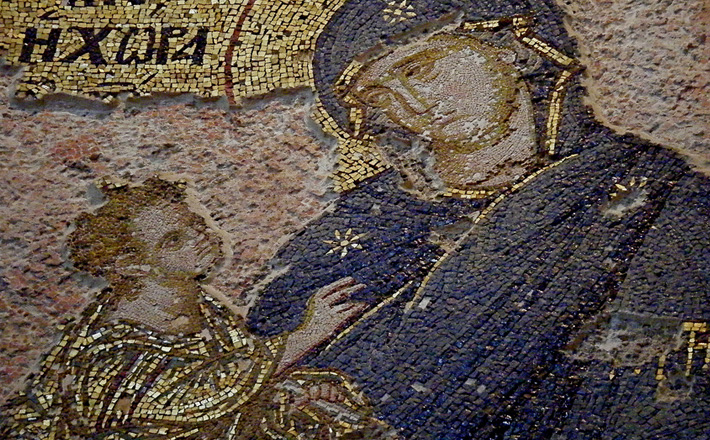Commentary on Isaiah 9:2-7
Isaiah 9:1 is not a part of the lectionary text, but helps put this Christmas Eve text in historical and literary context.1
This not altogether clear verse provides a transition between the darkness and gloom of 8:22 and the light and hope of 9:2-7.
The southern kingdom Judah had been threatened by a coalition from Syria and the northern kingdom (Israel). Judah’s king Ahaz, disregarding the counsel of Isaiah (see Isaiah 7:1-17; 8:4-8), had called on Assyria for help (see 2 Kings 16:1-20). The Assyrians under Tiglath-pileser III devastated Syria and the northern part of Israel (“Galilee”) in 733 BCE and sent many people into exile (see 2 Kings 15:29); in the process Judah became Assyria’s vassal. This threatening time constitutes the basic historical setting for the Isaiah 9:2-7 text. Contrasting images help shape the word delivered to Israel: darkness to light, death to life, anguish to hope.
Basically, Isaiah 9:2-7 consists of a song of praise and thanksgiving for what God has done (verses 2-6 are basically in the past tense). Note that these words are addressed to God (the “you” of verses 3-4), spoken by the prophet for the people (he is included among the “us” of verse 6). Verse 7 is in the future tense. The confidence related to the future is grounded in the divine action of the past.
Initially, a contrast is made between the gloomy past and the light-filled future that has already dawned (verse 2) and then the effects of God’s action are stated: the nation is thriving and the people are rejoicing (verse 3). The people’s joy is compared to the time of a successful harvest and the defeat of an enemy (with the dividing of the spoils).
The reasons for this transformed situation are stated with a threefold use of the word “for” (verses 4, 5, 6). Verse 4 recalls God’s breaking of the burden/yoke that had been laid upon the people (think of slavery). The event is compared to the unlikely defeat of Midian under Gideon (see Judges 6:2-6; 7:1-28). Verse 5 specifies the results of the victory in verse 4. The trampling boots of the enemy warriors and the bloody garments of their victims–instruments of war and their bloody effects–will be burned. These are images of the destruction of Israel’s enemies; they will be no more.
The effects of verses 4-5–God’s salvation!–are stated in socio-political-military terms. God’s will for justice and peace among the people is herein realized. These wide-ranging effects of God’s saving actions in and through the military-political sphere should not be reduced to a spiritual dimension. What modern parallels might be cited in, say, the practice of justice and socio-political activity? God works in and through agents from various spheres of the social fabric and all dimensions of life are positively affected. The result is called salvation.
It can be helpful to compare these acts of God’s salvation with the deliverance of Israel from slavery in Egypt (see “salvation” in Exodus 15:2). One might compare the multi-dimensional nature of God’s salvation here with the salvation language of the Gospels, which includes Jesus’ bodily healing and, in the end, the resurrection of the body. God’s salvation is a “full-bodied” experience–not unlike the best of red wines (see Isaiah 25:6)!
Verse 6 gives still another reason: a baby boy has been born (“It’s a boy”!). The birth of the child was promised in 7:14 as a sign of great things to come (Immanuel). His birth indicates that a new day has dawned (see also 9:4-5 as the fulfillment of 7:16). The earlier promise of God has come to birth. At this point the phrases “for us” and “to us” come to the fore (echoing the “with us” of 7:14). God has acted, not in general, but “for us”! The “birth” of the child may refer to the accession of the king to the throne (see Psalm 2:7), but the birth image remains important independently of royal imagery.
Who is this boy? The complex language of verse 6 has occasioned much reflection. Most interpreters see the use of royal motifs, perhaps even a ritual for the enthronement of a new Davidic king. He is usually identified with Hezekiah, on whom Isaiah 36-39 will focus (see 2 Kings 18:5-7 for a strongly positive evaluation of him). That such a reign is in mind may be seen in “the throne of David and his kingdom.” The four “throne names” in verse 6 are comparable to those given Egyptian pharaohs upon their enthronement. Without going into detail, they have the sense of: a discerning guide through the wilderness of life; an earthly representative of divine rule (not that the king is actually God–see the images in royal Psalm 45; see Immanuel); a parental presence that will assure ongoing care; a bringer of peace (note the word “prince,” not king).
Christians have, of course, seen the birth of Jesus through the lens provided by this language. But the song of thanksgiving context of these verses for already experienced salvation suggests that the answer to the question of the identity of the boy is more complex than any simple identification. It seems likely that, in view of continued failure on the part of Israel’s kings, the royal imagery used for the Davidic monarchy was applied to a coming king. At the same time, King Hezekiah provided a foretaste of this coming king in a way that no other Davidic ruler did. This text then becomes a song of thanksgiving for the anticipated rule of this coming prince who will rule as God himself rules.
Verse 7 makes a specific move to the future. Note that his authority will “grow”; it is not fully mature to begin with, but will not diminish. The theme of endless peace, justice, and righteousness anticipates the creation-wide, egalitarian rule specified more closely in Isaiah 11:1-9; Psalm 72:1; and Ezekiel 37:24-28. This future is possible because of what God has done and will do–the “zeal” of the Lord, that is, the passionate and unfailing commitment of God to work toward this future.
Notes:
1 This commentary was originally published on the site on December 24, 2009.


December 24, 2016